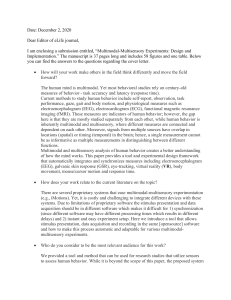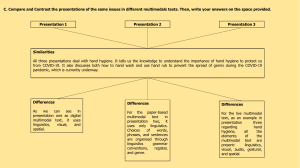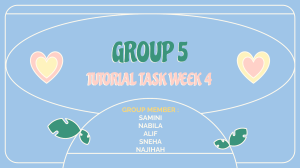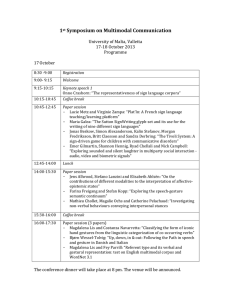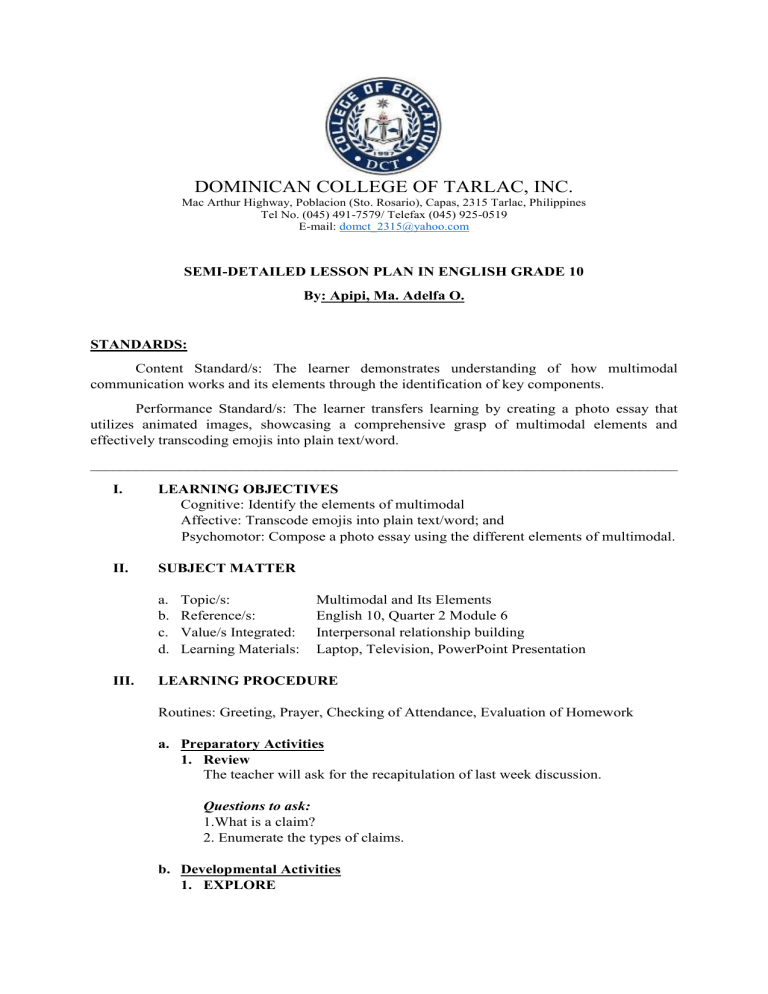
DOMINICAN COLLEGE OF TARLAC, INC. Mac Arthur Highway, Poblacion (Sto. Rosario), Capas, 2315 Tarlac, Philippines Tel No. (045) 491-7579/ Telefax (045) 925-0519 E-mail: domct_2315@yahoo.com SEMI-DETAILED LESSON PLAN IN ENGLISH GRADE 10 By: Apipi, Ma. Adelfa O. STANDARDS: Content Standard/s: The learner demonstrates understanding of how multimodal communication works and its elements through the identification of key components. Performance Standard/s: The learner transfers learning by creating a photo essay that utilizes animated images, showcasing a comprehensive grasp of multimodal elements and effectively transcoding emojis into plain text/word. ______________________________________________________________________________ I. LEARNING OBJECTIVES Cognitive: Identify the elements of multimodal Affective: Transcode emojis into plain text/word; and Psychomotor: Compose a photo essay using the different elements of multimodal. II. SUBJECT MATTER a. b. c. d. III. Topic/s: Reference/s: Value/s Integrated: Learning Materials: Multimodal and Its Elements English 10, Quarter 2 Module 6 Interpersonal relationship building Laptop, Television, PowerPoint Presentation LEARNING PROCEDURE Routines: Greeting, Prayer, Checking of Attendance, Evaluation of Homework a. Preparatory Activities 1. Review The teacher will ask for the recapitulation of last week discussion. Questions to ask: 1.What is a claim? 2. Enumerate the types of claims. b. Developmental Activities 1. EXPLORE Activity 1: Let`s Interpret! Directions: Give the proper meaning or interpretation of the given emojis. Example: BREAKTIME 1. 2. 3. 4. 5. 2. FIRM UP “Let`s Learn Multimodal and Its elements” What is communication? Communication is a two-way process that involves sending and receiving messages through verbal and non-verbal methods by means of communicating information between two or more individuals with the purpose of building an understanding. Modes include written language, spoken language, and patterns of meaning that are visual, audio, gestural, tactile and spatial. Multimodal texts, a multimodal text uses a combination of two or more communication modes, for example print, image and spoken text as in film or computer presentations. Types of Multimodal Text (This can be printed, physical, or digital.) Digital multimodal texts, are presented through combinations of written and audio, visual (still and moving image), gestural and spatial modes Live multimodal texts, are shown through combinations of modes such as gestural, spatial, spoken language, and audio Visual multimodal texts, these are representation of people, objects, and places that can be conveyed such as line, shape, size, line and symbols. Elements of Multimodal Text A text may be defined as multimodal when it combines two or more semiotic systems. • Linguistic: The linguistic mode refers to written or spoken words. The mode includes word choice, the delivery of written or spoken text, the organization of words into sentences and paragraphs, and the development and coherence of words and ideas. key terms: vocabulary, structure, grammar of oral/written language • Visual: The visual mode refers to the images and characters that people see. key terms: color, vectors and viewpoint in still and moving images • Audio or Aural: The aural mode is focused on sound including, but not limited to, music, sound effects, ambient noises, silence, tone of voice in spoken language, volume of sound, emphasis, and accent. key terms: volume, pitch and rhythm of music and sound effects • Gestural: The gestural mode “refers to the way movement is interpreted. Facial expressions, hand gestures, body language, and interaction between people are all gestural modes. key terms: movement, facial expression and body language • Spatial: The spatial mode, as the name implies, refers to the arrangement of elements in space. It involves the organization of items and the physical closeness between people and objects. A good example of the spatial mode might be the different ways in which chairs and desks are arranged in a classroom. key terms: proximity, direction, position of layout, organization of objects in space. 3. Transfer Activity 2: Picture or Image Perception Directions: Determine the type of modes using the pictures given. 1. 2. 3. 4. 5. 6. 7. 8. 9. 10. c. Closure Activity Generalization: Ask students how they understand the lesson by asking the following questions: Process question: 1. What do we mean by multimodal? 2. What are the types and elements of multimodal? IV. EVALUATION Directions: Read and answer the questions below with your knowledge of the topic discussed. Use a clean sheet of paper for your answers. Write the letter of your choice. 1. What is the other term for pictures? A. illustration B. still image C. image 2. Facial expressions is an example of _______. A. spatial B. gestural C. audio 3. This element of multimodal text observes the vocabulary and grammar. A. Linguistic B. Visual C. Spatial 4. This element of multimodal text uses color, images, and vector. A. Aural B. Spatial C. Visual 5. It is the movement of the body, the facial expression. A. Gestural B. Spatial C. Aural 6. Animation, Infographics, Screencast and eBook are examples of_____ A. Digital Multimodal B. Print Multimodal C. Physical Multimodal 7. Language modes (listening, speaking, reading, writing, viewing and videographing are often integrated in composing multimodal text. A. True B. False 8. Emojis are considered as gestural and visual. A. True B. False V. ASSIGNMENT Its Show Time! Each group will compose their own photo essay by using different multimodal text elements. Please be guided with the rubrics below. Topics: 1. Save Mother Earth 2. Importance of Reading 3. Say no to Bullying 4. The beauty of Bamban Checked by: ANGELITA A. MEDINA Cooperating Teacher
